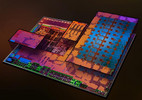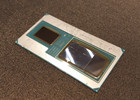AMD Radeon RX Vega 8 (Ryzen 2000/3000) vs AMD Radeon RX Vega M GH
AMD Radeon RX Vega 8 (Ryzen 2000/3000) ► remove from comparison
The AMD Radeon RX Vega 8 is an integrated GPU for notebooks. It is used for the Ryzen 5 APUs, which were launched in the end of 2017. The GPU is based on the Vega architecture (5th generation GCN) and has 8 CUs (= 512 of the 704 shaders) clocked at up to 1100 MHz (Ryzen 5 2500U). The performance depends on the configured TDP (12-25 W at launch), the clocks, the cooling, and the memory configuration). The GPU should benefit from fast dual-channel DDR4-2400 RAM (contrary to DDR4-2133 single-channel, which is also possible).
The Vega architecture offers some improvements over the Polaris generation and now supports DirectX 12 Feature Level 12_1. More information is available in our dedicated article about the Raven Ridge architecture .
AMD's reference design GPU is sitting between the GeForce 940MX / Radeon Pro 450 and GeForce MX150 / Radeon Pro 555. It can handle smooth gameplay in simple titles like League of Legends (med), Dota 2 (low), Overwatch (low), CS:GO (med), and Quake Champions (high) in 720p up to 1080p according to AMD.
Thanks to the 14nm process and clever power-saving features, the power consumption is comparatively low (according to AMD), so the graphics card can also be used for slim and light notebooks.
AMD Radeon RX Vega M GH ► remove from comparison
The AMD Radeon RX Vega M GH is an integrated GPU in the fastest Intel Kaby-Lake-G SoC. It combines a Kaby-Lake processor, a Vega graphics card and 4 GB HBM2 memory on a single package. The graphics card offers 24 CUs (1536 shaders) and is clocked from 1063 - 1190 MHz.
Currently it looks like the GPU is a mixture of Polaris (Shaders?) and Vega (HBM memory controller at least). E.g. the graphics card is called Polaris 22 internally. Detailed information on the Vega architecture can be found in our dedicated article about the Raven Ridge architecture .
The performance of the Vega M GH should be slightly slower than a dedicated Nvidia GeForce GTX 1060 for laptops according to benchmarks from Intel. Therefore, it should be well suited for 1080p and high resolution gaming.
The power consumption should be quite similar to a dedicated Vega Mobile GPU, but due to the small form factor, smaller laptops can be built with the Kaby-Lake-G SoC. The TDP is specified at 65 Watt for the whole package including GPU, CPU and HBM2 memory.
AMD Radeon RX Vega 8 (Ryzen 2000/3000) AMD Radeon RX Vega M GH AMD Radeon RX Vega Series Codename Vega Raven Ridge Vega Kaby Lake-G Architecture Vega Vega Pipelines 512 - unified 1536 - unified Core Speed 1200 (Boost) MHz 1063 - 1190 (Boost) MHz Shared Memory no no API DirectX 12_1 DirectX 12_1 Power Consumption 15 Watt 100 Watt Transistors 4.5 Billion technology 14 nm 14 nm Features Tiled Rasterization, Shared Memory (up to Dual-Channel DDR4-2400) Tiled Rasterization, Shared Memory (up to Dual-Channel DDR4-2400) Date of Announcement 26.10.2017 07.01.2018 Memory Type HBM2 Max. Amount of Memory 4 GB Notebook Size medium sized
CPU in Vega 8 GPU Base Speed GPU Boost / Turbo AMD Ryzen 5 3550H 4 x 2100 MHz, 35 W ? MHz 1200 MHz AMD Ryzen 3 2200G 4 x 3500 MHz, 65 W ? MHz 1100 MHz AMD Ryzen 5 3500U 4 x 2100 MHz, 15 W ? MHz 1200 MHz » show 6 more AMD Ryzen 5 PRO 3500U 4 x 2100 MHz, 15 W ? MHz 1200 MHz AMD Ryzen 5 3450U 4 x 2100 MHz, 15 W ? MHz 1200 MHz AMD Ryzen 5 2600H 4 x 3200 MHz, 45 W ? MHz 1100 MHz AMD Ryzen 5 2500U 4 x 2000 MHz, 15 W ? MHz 1100 MHz AMD Ryzen 5 PRO 2500U 4 x 2000 MHz, 15 W ? MHz 1100 MHz AMD Ryzen Embedded V1605B 4 x 2000 MHz, 15 W ? MHz 1100 MHz min. - max. ? MHz 1100 - 1200 MHz
CPU in Vega M GH GPU Base Speed GPU Boost / Turbo Intel Core i7-8809G 4 x 3100 MHz, 100 W 1063 MHz 1190 MHz Intel Core i7-8709G 4 x 3100 MHz, 100 W 1063 MHz 1190 MHz min. - max. 1063 - ? MHz 1100 - 1200 MHz
Benchmarks Performance Rating - 3DMark 11 + Fire Strike + Time Spy - Vega 8
1.1 pt (3%)
...
AMD Radeon RX Vega 8 (Ryzen 2000/3000)
...
max:
Performance Rating - 3DMark 11 + Fire Strike + Time Spy - Vega M GH
4.7 pt (14%)
...
...
max:
3DMark - 3DMark Time Spy Score
min: 587 avg: 756 median: 779 (2%) max: 882 Points
min: 2902 avg: 2999 median: 2999 (9%) max: 3096 Points
3DMark - 3DMark Time Spy Graphics
min: 523 avg: 673 median: 693 (2%) max: 790 Points
2908 Points (8%)
3DMark - 3DMark Ice Storm Unlimited Graphics
min: 82476 avg: 117107 median: 113247 (13%) max: 164146 Points
357446 Points (41%)
3DMark - 3DMark Ice Storm Extreme Graphics
min: 59083 avg: 67389 median: 67470 (9%) max: 74203 Points
282345 Points (36%)
3DMark - 3DMark Cloud Gate Score
min: 5527 avg: 10819 median: 11149 (12%) max: 13817 Points
min: 24532 avg: 24989 median: 24988.5 (27%) max: 25445 Points
3DMark - 3DMark Cloud Gate Graphics
min: 7309 avg: 15327 median: 15770 (4%) max: 19399 Points
59162 Points (16%)
3DMark - 3DMark Fire Strike Standard Score
min: 985 avg: 2009 median: 2142 (4%) max: 2645 Points
min: 7425 avg: 8693 median: 8506 (15%) max: 10147 Points
3DMark - 3DMark Fire Strike Standard Graphics
min: 1095 avg: 2224 median: 2381 (3%) max: 2901 Points
10248 Points (12%)
3DMark - 3DMark Ice Storm Graphics
min: 82476 avg: 92028 median: 92275 (11%) max: 99523 Points
319822 Points (38%)
3DMark - 3DMark Wild Life Unlimited
5156 Points (3%)
3DMark - 3DMark Night Raid
min: 5382 avg: 7643 median: 7670 (7%) max: 9150 Points
3DMark - 3DMark Night Raid Graphics Score
min: 5951 avg: 8960 median: 8859 (3%) max: 10846 Points
3DMark 11 - 3DM11 Performance Score
min: 1768 avg: 3539 median: 3676 (5%) max: 4528 Points
13212 Points (18%)
3DMark 11 - 3DM11 Performance GPU
min: 1668 avg: 3447 median: 3557 (3%) max: 4317 Points
14302 Points (12%)
3DMark Vantage + AMD Radeon RX Vega 8 (Ryzen 2000/3000) 3DMark Vantage - 3DM Vant. Perf. total
min: 9555 avg: 10294 median: 10294 (3%) max: 11033 Points
3DM Vant. Perf. GPU no PhysX + AMD Radeon RX Vega 8 (Ryzen 2000/3000) 3DMark Vantage - 3DM Vant. Perf. GPU no PhysX
min: 8461 avg: 8994 median: 8993.5 (5%) max: 9526 Points
3DMark 06 3DMark 06 - Standard 1280x1024 + AMD Radeon RX Vega 8 (Ryzen 2000/3000)
min: 10336 avg: 13392 median: 12213.5 (16%) max: 20501 Points
3DMark 06 - Standard 1280x1024 + AMD Radeon RX Vega M GH
33046 Points (43%)
3DMark 06 - Standard 1024x768 + AMD Radeon RX Vega 8 (Ryzen 2000/3000)
12775 Points (17%)
Unigine Valley 1.0 - Unigine Valley 1.0 DX
7.7 fps (3%)
Unigine Heaven 3.0 - Unigine Heaven 3.0 DX 11
27.3 fps (9%)
Unigine Heaven 3.0 - Unigine Heaven 3.0 OpenGL
18.6 fps (8%)
Unigine Heaven 2.1 - Heaven 2.1 high
25 fps (5%)
Blender - Blender 3.3 Classroom HIP *
926 Seconds (76%)
SPECviewperf 12 + AMD Radeon RX Vega M GH SPECviewperf 12 - specvp12 sw-03
66.9 fps (17%)
specvp12 snx-02 + AMD Radeon RX Vega M GH SPECviewperf 12 - specvp12 snx-02
20.8 fps (3%)
specvp12 showcase-01 + AMD Radeon RX Vega M GH SPECviewperf 12 - specvp12 showcase-01
49.3 fps (11%)
specvp12 mediacal-01 + AMD Radeon RX Vega M GH SPECviewperf 12 - specvp12 mediacal-01
21.4 fps (5%)
specvp12 maya-04 + AMD Radeon RX Vega M GH SPECviewperf 12 - specvp12 maya-04
54 fps (15%)
specvp12 energy-01 + AMD Radeon RX Vega M GH SPECviewperf 12 - specvp12 energy-01
3.5 fps (3%)
specvp12 creo-01 + AMD Radeon RX Vega M GH SPECviewperf 12 - specvp12 creo-01
45.6 fps (18%)
specvp12 catia-04 + AMD Radeon RX Vega M GH SPECviewperf 12 - specvp12 catia-04
77 fps (13%)
Cinebench R10 Cinebench R10 Shading (32bit) + AMD Radeon RX Vega 8 (Ryzen 2000/3000) Cinebench R10 - Cinebench R10 Shading (32bit)
min: 6929 avg: 7970 median: 7779.5 (6%) max: 10517 Points
Cinebench R10 Shading (32bit) + AMD Radeon RX Vega M GH
13015 Points (9%)
Cinebench R11.5 Cinebench R11.5 OpenGL 64 Bit + AMD Radeon RX Vega 8 (Ryzen 2000/3000) Cinebench R11.5 - Cinebench R11.5 OpenGL 64 Bit
min: 29.98 avg: 41 median: 39.1 (14%) max: 65 fps
Cinebench R11.5 OpenGL 64 Bit + AMD Radeon RX Vega M GH
123.3 fps (43%)
Cinebench R15 + AMD Radeon RX Vega 8 (Ryzen 2000/3000) Cinebench R15 - Cinebench R15 OpenGL 64 Bit
min: 24.5 avg: 46.3 median: 47.8 (3%) max: 74 fps
Cinebench R15 OpenGL 64 Bit + AMD Radeon RX Vega M GH
min: 136 avg: 144 median: 144 (8%) max: 151.9 fps
Cinebench R15 OpenGL Ref. Match 64 Bit + AMD Radeon RX Vega 8 (Ryzen 2000/3000) Cinebench R15 - Cinebench R15 OpenGL Ref. Match 64 Bit
min: 97.9 avg: 98 median: 98 (98%) max: 98 %
Cinebench R15 OpenGL Ref. Match 64 Bit + AMD Radeon RX Vega M GH
98 % (98%)
GFXBench - GFXBench 5.0 Aztec Ruins High Tier Offscreen
min: 19 avg: 22 median: 22.2 (4%) max: 24.8 fps
GFXBench - GFXBench 5.0 Aztec Ruins Normal Tier Offscreen
min: 45.5 avg: 54.2 median: 53 (4%) max: 64.2 fps
GFXBench - GFXBench Car Chase Offscreen
min: 31.1 avg: 38.7 median: 38.6 (4%) max: 46.4 fps
GFXBench 3.1 - GFXBench Manhattan ES 3.1 Offscreen
min: 36.3 avg: 43.5 median: 41.7 (1%) max: 54.3 fps
GFXBench 3.0 - GFXBench 3.0 Manhattan Offscreen
min: 32.1 avg: 43 median: 34.9 (2%) max: 70.2 fps
GFXBench (DX / GLBenchmark) 2.7 + AMD Radeon RX Vega 8 (Ryzen 2000/3000) GFXBench (DX / GLBenchmark) 2.7 - GFXBench T-Rex HD Offscreen C24Z16
min: 127.9 avg: 150.5 median: 146.5 (1%) max: 177.3 fps
LuxMark v2.0 64Bit - LuxMark v2.0 Room GPU
min: 281 avg: 342.5 median: 342.5 (2%) max: 404 Samples/s
1491 Samples/s (7%)
LuxMark v2.0 64Bit - LuxMark v2.0 Sala GPU
888 Samples/s (2%)
2867 Samples/s (5%)
ComputeMark v2.1 - ComputeMark v2.1 Result
min: 2206 avg: 2323 median: 2272 (2%) max: 2542 Points
6661 Points (7%)
Power Consumption - Furmark Stress Test Power Consumption - external Monitor *
min: 24.7 avg: 41.8 median: 38 (5%) max: 74.7 Watt
Power Consumption - The Witcher 3 Power Consumption - external Monitor *
min: 25.3 avg: 38.1 median: 35.9 (5%) max: 67.8 Watt
Power Consumption - Witcher 3 Power Consumption *
min: 30.3 avg: 40.3 median: 39.6 (9%) max: 50.3 Watt
121.7 Watt (27%)
Power Consumption - Witcher 3 ultra Power Efficiency
min: 0.1789 avg: 0.2 median: 0.2 (22%) max: 0.2693 fps per Watt
0.3 fps per Watt (28%)
Power Consumption - Witcher 3 ultra Power Efficiency - external Monitor
min: 0.2274 avg: 0.3 median: 0.3 (22%) max: 0.289 fps per Watt
Emissions Witcher 3 Fan Noise + AMD Radeon RX Vega 8 (Ryzen 2000/3000) Emissions - Witcher 3 Fan Noise
min: 30.6 avg: 39.6 median: 40 (64%) max: 51.9 dB(A)
Witcher 3 Fan Noise + AMD Radeon RX Vega M GH
42 dB(A) (67%)
Clock Speed - GPU Clock Witcher 3 ultra
min: 291 avg: 974 median: 957 (38%) max: 1750 MHz
1190 MHz (47%)
Clock Speed - GPU Clock Speed Furmark
min: 495 avg: 1122 median: 1150 (46%) max: 1500 MHz
1190 MHz (47%)
Average Benchmarks AMD Radeon RX Vega 8 (Ryzen 2000/3000) → 100% n=21 Average Benchmarks AMD Radeon RX Vega M GH → 310% n=21
- Range of benchmark values for this graphics card
- Average benchmark values for this graphics card
* Smaller numbers mean a higher performance
1 This benchmark is not used for the average calculation
Game Benchmarks The following benchmarks stem from our benchmarks of review laptops. The performance depends on the used graphics memory, clock rate, processor, system settings, drivers, and operating systems. So the results don't have to be representative for all laptops with this GPU. For detailed information on the benchmark results, click on the fps number.
100%
Vega 8:
12.4 [X] HP ProBook 455R G6 6UK72ES AMD Ryzen 5 3500U 2.1GHz
Vega 8
min:
1.46 fps, P0.1:
1.752 fps, P1:
5.42 fps, max:
94.2 fps
fps
100%
Vega 8:
16.5 [X] HP ProBook 455R G6 6UK72ES AMD Ryzen 5 3500U 2.1GHz
Vega 8
min:
6.9 fps, P0.1:
7.1 fps, P1:
8.15 fps, max:
75.4 fps
fps
100%
Vega 8:
14.4 [X] HP ProBook 455R G6 6UK72ES AMD Ryzen 5 3500U 2.1GHz
Vega 8
min:
3.73 fps, P0.1:
4.14 fps, P1:
6.23 fps, max:
87.8 fps
fps
100%
Vega 8:
7.7 [X] HP ProBook 455R G6 6UK72ES AMD Ryzen 5 3500U 2.1GHz
Vega 8
min:
4.85 fps, P0.1:
5.04 fps, P1:
5.66 fps, max:
10.3 fps
fps
100%
Vega 8:
7.5 [X] HP ProBook 455R G6 6UK72ES AMD Ryzen 5 3500U 2.1GHz
Vega 8
min:
5.32 fps, P0.1:
5.4 fps, P1:
5.82 fps, max:
11 fps
fps
100%
Vega 8:
18.4 [X] HP ProBook 455R G6 6UK72ES AMD Ryzen 5 3500U 2.1GHz
Vega 8
P0.1:
7.2 fpsP1:
10.2 fps
fps
100%
Vega 8:
13.8 [X] HP ProBook 455R G6 6UK72ES AMD Ryzen 5 3500U 2.1GHz
Vega 8
P0.1:
7.5 fpsP1:
8.8 fps
fps
100%
Vega 8:
12.3 [X] HP ProBook 455R G6 6UK72ES AMD Ryzen 5 3500U 2.1GHz
Vega 8
min:
5.05 fps, P0.1:
5.2 fps, P1:
6.79 fps, max:
23.3 fps
fps
100%
Vega 8:
13.9 [X] HP ProBook 455R G6 6UK72ES AMD Ryzen 5 3500U 2.1GHz
Vega 8
min:
8.5 fps, P0.1:
10.5 fps, P1:
11.5 fps, max:
42.7 fps
fps
100%
Vega 8:
10.3 [X] HP ProBook 455R G6 6UK72ES AMD Ryzen 5 3500U 2.1GHz
Vega 8
min:
8.52 fps, P0.1:
8.73 fps, P1:
9.13 fps, max:
12.4 fps
fps
100%
Vega 8:
7 [X] HP ProBook 455R G6 6UK72ES AMD Ryzen 5 3500U 2.1GHz
Vega 8
min:
2 fps, max:
24 fps
fps
100%
Vega 8:
10.5 [X] HP ProBook 455R G6 6UK72ES AMD Ryzen 5 3500U 2.1GHz
Vega 8
min:
6.16 fps, P0.1:
6.22 fps, P1:
7.11 fps, max:
25.3 fps
fps
100%
Vega 8:
14 [X] HP ProBook 455R G6 6UK72ES AMD Ryzen 5 3500U 2.1GHz
Vega 8
min:
3.29 fps, P0.1:
6.99 fps, P1:
11.2 fps, max:
74 fps
fps
100%
Vega 8:
17.4 [X] HP ProBook 455R G6 6UK72ES AMD Ryzen 5 3500U 2.1GHz
Vega 8
min:
7.03 fps, P0.1:
7.31 fps, P1:
8.22 fps, max:
69.1 fps
fps
100%
Vega 8:
9.8 [X] HP ProBook 455R G6 6UK72ES AMD Ryzen 5 3500U 2.1GHz
Vega 8
min:
4.17 fps, P0.1:
4.19 fps, P1:
4.26 fps, max:
56.7 fps
fps
100%
Vega 8:
12.5 [X] HP ProBook 455R G6 6UK72ES AMD Ryzen 5 3500U 2.1GHz
Vega 8
fps
100%
Vega 8:
8.1 [X] HP ProBook 455R G6 6UK72ES AMD Ryzen 5 3500U 2.1GHz
Vega 8
fps
100%
Vega 8:
7.4 [X] HP ProBook 455R G6 6UK72ES AMD Ryzen 5 3500U 2.1GHz
Vega 8
fps
100%
Vega 8:
12.2 [X] HP ProBook 455R G6 6UK72ES AMD Ryzen 5 3500U 2.1GHz
Vega 8
min:
7.91 fps, P0.1:
8.27 fps, P1:
8.91 fps, max:
23 fps
fps
100%
Vega 8:
11.2 [X] HP ProBook 455R G6 6UK72ES AMD Ryzen 5 3500U 2.1GHz
Vega 8
min:
7.58 fps, P0.1:
7.96 fps, P1:
9.26 fps, max:
15.5 fps
fps
100%
Vega 8:
14 [X] HP ProBook 455R G6 6UK72ES AMD Ryzen 5 3500U 2.1GHz
Vega 8
min:
7 fps
fps
100%
Vega 8:
12 [X] HP ProBook 455R G6 6UK72ES AMD Ryzen 5 3500U 2.1GHz
Vega 8
min:
5 fps
fps
100%
Vega 8:
11 [X] HP ProBook 455R G6 6UK72ES AMD Ryzen 5 3500U 2.1GHz
Vega 8
min:
2 fps
fps
100%
Vega 8:
8.3 [X] HP ProBook 455R G6 6UK72ES AMD Ryzen 5 3500U 2.1GHz
Vega 8
min:
5.42 fps, P0.1:
5.48 fps, P1:
5.98 fps, max:
9.63 fps
fps
100%
Vega 8:
7.3 [X] HP ProBook 455R G6 6UK72ES AMD Ryzen 5 3500U 2.1GHz
Vega 8
min:
4.14 fps, P0.1:
4.27 fps, P1:
5.38 fps, max:
8.59 fps
fps
100%
Vega 8:
9 [X] HP ProBook 455R G6 6UK72ES AMD Ryzen 5 3500U 2.1GHz
Vega 8
min:
6.33 fps, P0.1:
6.39 fps, P1:
6.77 fps, max:
12.3 fps
fps
100%
Vega 8:
10.7 [X] HP ProBook 455R G6 6UK72ES AMD Ryzen 5 3500U 2.1GHz
Vega 8
min:
6.11 fps, P0.1:
6.46 fps, P1:
7.5 fps, max:
16.3 fps
fps
100%
Vega 8:
21.7 [X] HP ProBook 455R G6 6UK72ES 959964
AMD Ryzen 5 3500U 2.1GHz
Vega 8
min:
16 fps, P1:
15 fps, max:
27 fps
fps
100%
Vega 8:
20.8 [X] HP ProBook 455R G6 6UK72ES 959964
AMD Ryzen 5 3500U 2.1GHz
Vega 8
min:
16 fps, P1:
13 fps, max:
24 fps
fps
100%
Vega 8:
16.6 [X] HP ProBook 455R G6 6UK72ES 959964
AMD Ryzen 5 3500U 2.1GHz
Vega 8
min:
12 fps, P1:
12 fps, max:
20 fps
fps
100%
Vega 8:
11.3 [X] HP ProBook 455R G6 6UK72ES 959964
AMD Ryzen 5 3500U 2.1GHz
Vega 8
min:
8 fps, P1:
8 fps, max:
14 fps
fps
100%
Vega 8:
22.5 [X] HP ProBook 455R G6 6UK72ES AMD Ryzen 5 3500U 2.1GHz
Vega 8
min:
5.01 fps, P0.1:
6.78 fps, P1:
13.5 fps, max:
74.7 fps
fps
100%
Vega 8:
15.2 [X] HP ProBook 455R G6 6UK72ES AMD Ryzen 5 3500U 2.1GHz
Vega 8
min:
2.94 fps, P0.1:
3.85 fps, P1:
7.62 fps, max:
117.9 fps
fps
100%
Vega 8:
12.6 [X] HP ProBook 455R G6 6UK72ES AMD Ryzen 5 3500U 2.1GHz
Vega 8
min:
4 fps, P0.1:
4.41 fps, P1:
7.57 fps, max:
63.5 fps
fps
100%
Vega 8:
10 [X] HP ProBook 455R G6 6UK72ES AMD Ryzen 5 3500U 2.1GHz
Vega 8
min:
4.53 fps, P0.1:
4.6 fps, P1:
5.12 fps, max:
54.3 fps
fps
100%
Vega 8:
16.3 [X] HP ProBook 455R G6 6UK72ES AMD Ryzen 5 3500U 2.1GHz
Vega 8
fps
100%
Vega 8:
12 [X] HP ProBook 455R G6 6UK72ES AMD Ryzen 5 3500U 2.1GHz
Vega 8
fps
100%
Vega 8:
7.9 [X] HP ProBook 455R G6 6UK72ES AMD Ryzen 5 3500U 2.1GHz
Vega 8
fps
100%
Vega 8:
7.7 [X] HP ProBook 455R G6 6UK72ES AMD Ryzen 5 3500U 2.1GHz
Vega 8
min:
3.1 fps, max:
19.8 fps
10.8 [X] Trigkey S3 AMD Ryzen 5 3550H 2.1GHz
Vega 8
min:
7.4 fps, max:
14.9 fps
~ 9 fps
100%
Vega 8:
8.6 [X] Trigkey S3 AMD Ryzen 5 3550H 2.1GHz
Vega 8
min:
5.5 fps, max:
11.8 fps
fps
100%
Vega 8:
6.3 [X] Trigkey S3 AMD Ryzen 5 3550H 2.1GHz
Vega 8
min:
4.5 fps, max:
8.6 fps
fps
100%
Vega 8:
5 [X] Trigkey S3 AMD Ryzen 5 3550H 2.1GHz
Vega 8
min:
3.2 fps, max:
7 fps
fps
100%
Vega 8:
13 [X] HP ProBook 455R G6 6UK72ES AMD Ryzen 5 3500U 2.1GHz
Vega 8
min:
5.8 fps, P0.1:
6.26 fps, P1:
8.29 fps, max:
24.2 fps
fps
100%
Vega 8:
32.3 [X] HP ProBook 455R G6 6UK72ES AMD Ryzen 5 3500U 2.1GHz
Vega 8
min:
22.4 fps, max:
47.8 fps
fps
100%
Vega 8:
19.5 [X] HP ProBook 455R G6 6UK72ES AMD Ryzen 5 3500U 2.1GHz
Vega 8
min:
14.5 fps, max:
27.4 fps
fps
100%
Vega 8:
16.4 [X] HP ProBook 455R G6 6UK72ES AMD Ryzen 5 3500U 2.1GHz
Vega 8
min:
12.4 fps, max:
22.5 fps
fps
100%
Vega 8:
13 [X] HP ProBook 455R G6 6UK72ES AMD Ryzen 5 3500U 2.1GHz
Vega 8
min:
6.54 fps, P0.1:
6.55 fps, P1:
8.49 fps, max:
27.4 fps
fps
100%
Vega 8:
12 [X] HP ProBook 455R G6 6UK72ES AMD Ryzen 5 3500U 2.1GHz
Vega 8
min:
6.61 fps, P0.1:
7.11 fps, P1:
8.23 fps, max:
24.4 fps
fps
100%
Vega 8:
8 [X] HP ProBook 455R G6 6UK72ES AMD Ryzen 5 3500U 2.1GHz
Vega 8
min:
6.59 fps, P0.1:
6.67 fps, P1:
7.07 fps, max:
9.74 fps
fps
100%
Vega 8:
19 [X] HP ProBook 455R G6 6UK72ES AMD Ryzen 5 3500U 2.1GHz
Vega 8
min:
12 fps, max:
23 fps
fps
100%
Vega 8:
14 [X] HP ProBook 455R G6 6UK72ES AMD Ryzen 5 3500U 2.1GHz
Vega 8
min:
10 fps, max:
17 fps
fps
100%
Vega 8:
56.9 [X] HP ProBook 455R G6 6UK72ES AMD Ryzen 5 3500U 2.1GHz
Vega 8
min:
5.02 fps, P0.1:
10.1 fps, P1:
27.7 fps, max:
103.1 fps
fps
100%
Vega 8:
27.6 [X] HP ProBook 455R G6 6UK72ES AMD Ryzen 5 3500U 2.1GHz
Vega 8
min:
3.94 fps, P0.1:
4.08 fps, P1:
6.53 fps, max:
81.1 fps
fps
100%
Vega 8:
39 [X] Lenovo V155-15API 81V5001VGE AMD Ryzen 5 3500U 2.1GHz
Vega 8
fps
100%
Vega 8:
17 [X] Lenovo V155-15API 81V5001VGE AMD Ryzen 5 3500U 2.1GHz
Vega 8
fps
100%
Vega 8:
27 [X] Lenovo V155-15API 81V5001VGE AMD Ryzen 5 3500U 2.1GHz
Vega 8
min:
9 fps, max:
37 fps
fps
100%
Vega 8:
12 [X] Lenovo V155-15API 81V5001VGE AMD Ryzen 5 3500U 2.1GHz
Vega 8
min:
7 fps, max:
16 fps
fps
100%
Vega 8:
51.2 [X] Lenovo V155-15API 81V5001VGE AMD Ryzen 5 3500U 2.1GHz
Vega 8
min:
9.66 fps, P0.1:
13.1 fps, P1:
21.3 fps, max:
174 fps
fps
100%
Vega 8:
17.9 [X] Lenovo V155-15API 81V5001VGE AMD Ryzen 5 3500U 2.1GHz
Vega 8
min:
7.5 fps, P0.1:
7.54 fps, P1:
8.19 fps, max:
124 fps
fps
100%
Vega 8:
14.9 [X] Lenovo V155-15API 81V5001VGE AMD Ryzen 5 3500U 2.1GHz
Vega 8
min:
6.37 fps, P0.1:
6.38 fps, P1:
6.75 fps, max:
150 fps
fps
100%
Vega 8:
13.6 [X] Lenovo V155-15API 81V5001VGE AMD Ryzen 5 3500U 2.1GHz
Vega 8
min:
5.34 fps, P0.1:
5.48 fps, P1:
6.07 fps, max:
135 fps
fps
100%
Vega 8:
24 [X] Lenovo V155-15API 81V5001VGE AMD Ryzen 5 3500U 2.1GHz
Vega 8
min:
6 fps, max:
27 fps
fps
100%
Vega 8:
32.5 [X] Lenovo V155-15API 81V5001VGE AMD Ryzen 5 3500U 2.1GHz
Vega 8
min:
14 fps, P0.1:
16.8 fps, P1:
20.3 fps, max:
41.8 fps
fps
100%
Vega 8:
13.7 [X] Lenovo V155-15API 81V5001VGE AMD Ryzen 5 3500U 2.1GHz
Vega 8
min:
5.32 fps, P0.1:
6.68 fps, P1:
9.1 fps, max:
35.8 fps
fps
100%
Vega 8:
40.2 [X] Lenovo V155-15API 81V5001VGE AMD Ryzen 5 3500U 2.1GHz
Vega 8
min:
28.1 fps, P0.1:
31.5 fps, P1:
33.5 fps, max:
63.3 fps
fps
100%
Vega 8:
17.6 [X] Lenovo V155-15API 81V5001VGE AMD Ryzen 5 3500U 2.1GHz
Vega 8
min:
9.59 fps, P0.1:
9.8 fps, P1:
10.9 fps, max:
50.7 fps
fps
100%
Vega 8:
23.7 [X] Lenovo V155-15API 81V5001VGE AMD Ryzen 5 3500U 2.1GHz
Vega 8
min:
4.26 fps, P0.1:
5.25 fps, P1:
16.9 fps, max:
46.1 fps
fps
100%
Vega 8:
11.2 [X] Lenovo V155-15API 81V5001VGE AMD Ryzen 5 3500U 2.1GHz
Vega 8
min:
3.66 fps, P0.1:
4.11 fps, P1:
6.09 fps, max:
14.3 fps
fps
100%
Vega 8:
31.5 54.3 [X] Dell Inspiron 15 3505-PXHPW 865624, Dual-Channel
AMD Ryzen 5 3450U 2.1GHz
Vega 8
min:
38 fps, P1:
38 fps, max:
66 fps
58.4 [X] Lenovo V155-15API 81V5001VGE 807588
AMD Ryzen 5 3500U 2.1GHz
Vega 8
min:
44 fps, P1:
39 fps, max:
71 fps
~ 48 fps
100%
Vega 8:
14.1 20.9 [X] Dell Inspiron 15 3505-PXHPW 865624, Dual-Channel
AMD Ryzen 5 3450U 2.1GHz
Vega 8
min:
16 fps, P1:
15 fps, max:
23 fps
24 [X] Lenovo V155-15API 81V5001VGE 807588
AMD Ryzen 5 3500U 2.1GHz
Vega 8
min:
18 fps, P1:
15 fps, max:
28 fps
~ 20 fps
100%
Vega 8:
10.7 18.3 [X] Lenovo V155-15API 81V5001VGE 807588
AMD Ryzen 5 3500U 2.1GHz
Vega 8
min:
11 fps, P1:
11 fps, max:
22 fps
18.4 [X] Dell Inspiron 15 3505-PXHPW 865624, Dual-Channel
AMD Ryzen 5 3450U 2.1GHz
Vega 8
min:
14 fps, P1:
13 fps, max:
24 fps
~ 16 fps
100%
Vega 8:
50.6 [X] Lenovo V155-15API 81V5001VGE AMD Ryzen 5 3500U 2.1GHz
Vega 8
min:
34.1 fps, P0.1:
35.4 fps, P1:
37.6 fps, max:
63 fps
fps
100%
Vega 8:
28.3 [X] Lenovo V155-15API 81V5001VGE AMD Ryzen 5 3500U 2.1GHz
Vega 8
min:
21.6 fps, P0.1:
21.7 fps, P1:
22.2 fps, max:
35.4 fps
fps
100%
Vega 8:
23.8 [X] Lenovo V155-15API 81V5001VGE AMD Ryzen 5 3500U 2.1GHz
Vega 8
min:
7.86 fps, P0.1:
8.02 fps, P1:
16.4 fps, max:
29.5 fps
fps
100%
Vega 8:
17 [X] Lenovo V155-15API 81V5001VGE AMD Ryzen 5 3500U 2.1GHz
Vega 8
min:
6.09 fps, P0.1:
7.5 fps, P1:
10.5 fps, max:
56.8 fps
fps
100%
Vega 8:
11.9 [X] Lenovo V155-15API 81V5001VGE AMD Ryzen 5 3500U 2.1GHz
Vega 8
min:
4.76 fps, P0.1:
5.72 fps, P1:
8.81 fps, max:
36.4 fps
fps
100%
Vega 8:
28.1 [X] Lenovo V155-15API 81V5001VGE AMD Ryzen 5 3500U 2.1GHz
Vega 8
min:
19.4 fps, P0.1:
19.7 fps, P1:
21 fps, max:
38.5 fps
fps
100%
Vega 8:
14.8 [X] Lenovo V155-15API 81V5001VGE AMD Ryzen 5 3500U 2.1GHz
Vega 8
min:
10.8 fps, P0.1:
11.2 fps, P1:
11.8 fps, max:
18.7 fps
fps
100%
Vega 8:
28.6 [X] Lenovo V155-15API 81V5001VGE AMD Ryzen 5 3500U 2.1GHz
Vega 8
min:
14.2 fps, P0.1:
14.5 fps, P1:
17.5 fps, max:
61.4 fps
fps
100%
Vega 8:
17.8 [X] Lenovo V155-15API 81V5001VGE AMD Ryzen 5 3500U 2.1GHz
Vega 8
min:
8.35 fps, P0.1:
8.47 fps, P1:
9.03 fps, max:
58.6 fps
fps
100%
Vega 8:
11.9 [X] Lenovo V155-15API 81V5001VGE AMD Ryzen 5 3500U 2.1GHz
Vega 8
min:
5.28 fps, P0.1:
5.34 fps, P1:
5.66 fps, max:
49.1 fps
fps
100%
Vega 8:
10.5 [X] Lenovo V155-15API 81V5001VGE AMD Ryzen 5 3500U 2.1GHz
Vega 8
min:
3.76 fps, P0.1:
3.91 fps, P1:
4.59 fps, max:
59.3 fps
fps
100%
Vega 8:
44.4 [X] Lenovo V155-15API 81V5001VGE AMD Ryzen 5 3500U 2.1GHz
Vega 8
fps
100%
Vega 8:
16.8 [X] Lenovo V155-15API 81V5001VGE AMD Ryzen 5 3500U 2.1GHz
Vega 8
min:
7.39 fps, P0.1:
7.48 fps, P1:
9.31 fps, max:
44.8 fps
fps
100%
Vega 8:
27 [X] Lenovo V155-15API 81V5001VGE AMD Ryzen 5 3500U 2.1GHz
Vega 8
min:
8 fps, max:
48 fps
fps
100%
Vega 8:
13 [X] Lenovo V155-15API 81V5001VGE AMD Ryzen 5 3500U 2.1GHz
Vega 8
min:
6 fps, max:
31 fps
fps
100%
Vega 8:
12 [X] Lenovo V155-15API 81V5001VGE AMD Ryzen 5 3500U 2.1GHz
Vega 8
min:
6 fps, max:
25 fps
fps
100%
Vega 8:
26.1 [X] Lenovo V155-15API 81V5001VGE AMD Ryzen 5 3500U 2.1GHz
Vega 8
min:
17.4 fps, P0.1:
17.9 fps, P1:
19.7 fps, max:
54.3 fps
fps
100%
Vega 8:
9.4 [X] Lenovo V155-15API 81V5001VGE AMD Ryzen 5 3500U 2.1GHz
Vega 8
min:
7 fps, P0.1:
7.14 fps, P1:
7.6 fps, max:
12.6 fps
fps
100%
Vega 8:
23 [X] Lenovo V155-15API 81V5001VGE AMD Ryzen 5 3500U 2.1GHz
Vega 8
min:
7 fps, max:
50 fps
fps
100%
Vega 8:
10 [X] Lenovo V155-15API 81V5001VGE AMD Ryzen 5 3500U 2.1GHz
Vega 8
min:
5 fps, max:
36 fps
fps
100%
Vega 8:
30.7 [X] Lenovo V155-15API 81V5001VGE AMD Ryzen 5 3500U 2.1GHz
Vega 8
min:
15.6 fps, P0.1:
17 fps, P1:
19.9 fps, max:
37.7 fps
fps
100%
Vega 8:
11.7 [X] Lenovo V155-15API 81V5001VGE AMD Ryzen 5 3500U 2.1GHz
Vega 8
min:
7 fps, P0.1:
7.5 fps, P1:
8 fps, max:
14.6 fps
fps
100%
Vega 8:
8.8 [X] Lenovo V155-15API 81V5001VGE AMD Ryzen 5 3500U 2.1GHz
Vega 8
min:
5.8 fps, P0.1:
5.9 fps, P1:
6.4 fps, max:
10.6 fps
fps
100%
Vega 8:
21 [X] Lenovo V155-15API 81V5001VGE AMD Ryzen 5 3500U 2.1GHz
Vega 8
min:
9.97 fps, P1:
14.15 fps, max:
30.43 fps
fps
100%
Vega 8:
11.6 [X] Lenovo V155-15API 81V5001VGE AMD Ryzen 5 3500U 2.1GHz
Vega 8
min:
6.35 fps, P1:
7.94 fps, max:
16.74 fps
fps
100%
Vega 8:
35.5 [X] Lenovo V155-15API 81V5001VGE AMD Ryzen 5 3500U 2.1GHz
Vega 8
min:
9.18 fps, P0.1:
10.6 fps, P1:
14.3 fps, max:
165 fps
fps
100%
Vega 8:
7.1 [X] Lenovo V155-15API 81V5001VGE AMD Ryzen 5 3500U 2.1GHz
Vega 8
min:
2.39 fps, P0.1:
2.44 fps, P1:
3.33 fps, max:
59.3 fps
fps
100%
Vega 8:
24 26.8 [X] Lenovo V155-15API 81V5001VGE AMD Ryzen 5 3500U 2.1GHz
Vega 8
min:
13.3 fps, P0.1:
13.8 fps, P1:
19.6 fps, max:
34.5 fps
~ 25 fps
100%
Vega 8:
14.7 [X] Lenovo V155-15API 81V5001VGE AMD Ryzen 5 3500U 2.1GHz
Vega 8
min:
9.9 fps, P0.1:
10.3 fps, P1:
12 fps, max:
27.2 fps
15.6 ~ 15 fps
100%
Vega 8:
13.5 [X] Lenovo V155-15API 81V5001VGE AMD Ryzen 5 3500U 2.1GHz
Vega 8
min:
6.88 fps, P0.1:
8.21 fps, P1:
11 fps, max:
20.4 fps
14.3 ~ 14 fps
100%
Vega 8:
13.1 [X] Lenovo V155-15API 81V5001VGE AMD Ryzen 5 3500U 2.1GHz
Vega 8
min:
7.62 fps, P0.1:
8.38 fps, P1:
10 fps, max:
21.9 fps
14 ~ 14 fps
100%
Vega 8:
57.9 62.1 65.1 [X] Lenovo V155-15API 81V5001VGE AMD Ryzen 5 3500U 2.1GHz
Vega 8
~ 62 fps
100%
Vega 8:
20.8 21.5 23.1 [X] Lenovo V155-15API 81V5001VGE AMD Ryzen 5 3500U 2.1GHz
Vega 8
~ 22 fps
100%
Vega 8:
13 13.9 13.9 [X] Lenovo V155-15API 81V5001VGE AMD Ryzen 5 3500U 2.1GHz
Vega 8
~ 14 fps
100%
Vega 8:
9.3 [X] Lenovo V155-15API 81V5001VGE AMD Ryzen 5 3500U 2.1GHz
Vega 8
9.5 ~ 9 fps
100%
Vega 8:
39.6 [X] Lenovo V155-15API 81V5001VGE AMD Ryzen 5 3500U 2.1GHz
Vega 8
43 [X] Beelink GTR35 II-G-16512D00W64PRO-1T 54 Watt AMD Ryzen 5 3550H 2.1GHz
Vega 8
45 ~ 43 fps
100%
Vega 8:
19.9 [X] Lenovo V155-15API 81V5001VGE AMD Ryzen 5 3500U 2.1GHz
Vega 8
22 25 [X] Beelink GTR35 II-G-16512D00W64PRO-1T 54 Watt AMD Ryzen 5 3550H 2.1GHz
Vega 8
~ 22 fps
100%
Vega 8:
17.6 [X] Lenovo V155-15API 81V5001VGE AMD Ryzen 5 3500U 2.1GHz
Vega 8
20 21 [X] Beelink GTR35 II-G-16512D00W64PRO-1T 54 Watt AMD Ryzen 5 3550H 2.1GHz
Vega 8
~ 20 fps
100%
Vega 8:
14 [X] Beelink GTR35 II-G-16512D00W64PRO-1T 54 Watt AMD Ryzen 5 3550H 2.1GHz
Vega 8
16 ~ 15 fps
100%
Vega 8:
27.9 29.5 [X] Lenovo V155-15API 81V5001VGE AMD Ryzen 5 3500U 2.1GHz
Vega 8
~ 29 fps
100%
Vega 8:
11.2 11.4 [X] Lenovo V155-15API 81V5001VGE AMD Ryzen 5 3500U 2.1GHz
Vega 8
~ 11 fps
100%
Vega 8:
33.7 41.7 [X] Lenovo V155-15API 81V5001VGE AMD Ryzen 5 3500U 2.1GHz
Vega 8
~ 38 fps
100%
Vega 8:
13.6 [X] Lenovo V155-15API 81V5001VGE AMD Ryzen 5 3500U 2.1GHz
Vega 8
16 ~ 15 fps
100%
Vega 8:
24.4 25 [X] Lenovo V155-15API 81V5001VGE AMD Ryzen 5 3500U 2.1GHz
Vega 8
~ 25 fps
100%
Vega 8:
10.8 [X] Lenovo V155-15API 81V5001VGE AMD Ryzen 5 3500U 2.1GHz
Vega 8
12.6 ~ 12 fps
100%
Vega 8:
16.2 [X] Honor Magicbook AMD Ryzen 5 2500U 2GHz
Vega 8
min:
13 fps
fps
100%
Vega 8:
11.4 [X] Honor Magicbook AMD Ryzen 5 2500U 2GHz
Vega 8
min:
6 fps
fps
100%
Vega 8:
9.9 [X] Honor Magicbook AMD Ryzen 5 2500U 2GHz
Vega 8
min:
7 fps
fps
100%
Vega 8:
25.8 [X] Honor Magicbook AMD Ryzen 5 2500U 2GHz
Vega 8
min:
13 fps
fps
100%
Vega 8:
12.1 [X] Honor Magicbook AMD Ryzen 5 2500U 2GHz
Vega 8
min:
9 fps
fps
100%
Vega 8:
10.1 [X] Honor Magicbook AMD Ryzen 5 2500U 2GHz
Vega 8
min:
7 fps
fps
100%
Vega 8:
25.2 [X] Lenovo V155-15API 81V5001VGE AMD Ryzen 5 3500U 2.1GHz
Vega 8
fps
100%
Vega 8:
15.5 [X] Lenovo V155-15API 81V5001VGE AMD Ryzen 5 3500U 2.1GHz
Vega 8
fps
100%
Vega 8:
11.4 [X] Lenovo V155-15API 81V5001VGE AMD Ryzen 5 3500U 2.1GHz
Vega 8
fps
100%
Vega 8:
28.8 [X] Honor Magicbook AMD Ryzen 5 2500U 2GHz
Vega 8
min:
25 fps
39.1 ~ 34 fps
100%
Vega 8:
13.7 [X] Honor Magicbook AMD Ryzen 5 2500U 2GHz
Vega 8
min:
11 fps
18.5 ~ 16 fps
100%
Vega 8:
12.4 [X] Honor Magicbook AMD Ryzen 5 2500U 2GHz
Vega 8
min:
9 fps
13.6 ~ 13 fps
100%
Vega 8:
17 20 [X] Honor Magicbook AMD Ryzen 5 2500U 2GHz
Vega 8
min:
12 fps
~ 19 fps
100%
Vega 8:
9 11 [X] Honor Magicbook AMD Ryzen 5 2500U 2GHz
Vega 8
min:
7 fps
~ 10 fps
100%
Vega 8:
9 10 [X] Honor Magicbook AMD Ryzen 5 2500U 2GHz
Vega 8
min:
3 fps
~ 10 fps
100%
Vega 8:
7 [X] Honor Magicbook AMD Ryzen 5 2500U 2GHz
Vega 8
min:
2 fps
fps
100%
Vega 8:
99.5 [X] Honor Magicbook AMD Ryzen 5 2500U 2GHz
Vega 8
min:
75 fps
103.7 ~ 102 fps
100%
Vega 8:
57.6 [X] Honor Magicbook AMD Ryzen 5 2500U 2GHz
Vega 8
min:
47 fps
58.5 ~ 58 fps
100%
Vega 8:
46.8 [X] Honor Magicbook AMD Ryzen 5 2500U 2GHz
Vega 8
min:
38 fps
49.8 ~ 48 fps
100%
Vega 8:
40.1 [X] Honor Magicbook AMD Ryzen 5 2500U 2GHz
Vega 8
min:
34 fps
41.1 ~ 41 fps
100%
Vega 8:
32 [X] Honor Magicbook AMD Ryzen 5 2500U 2GHz
Vega 8
34.9 49.1 [X] AMD Ryzen 3 2200G 3.5GHz
Vega 8
~ 39 fps
100%
Vega 8:
13.7 [X] Honor Magicbook AMD Ryzen 5 2500U 2GHz
Vega 8
14.2 18.7 [X] AMD Ryzen 3 2200G 3.5GHz
Vega 8
~ 16 fps
100%
Vega 8:
9 9.1 [X] Honor Magicbook AMD Ryzen 5 2500U 2GHz
Vega 8
11.8 [X] AMD Ryzen 3 2200G 3.5GHz
Vega 8
~ 10 fps
100%
Vega 8:
6.5 [X] Honor Magicbook AMD Ryzen 5 2500U 2GHz
Vega 8
7.1 7.5 [X] AMD Ryzen 3 2200G 3.5GHz
Vega 8
~ 7 fps
100%
Vega 8:
25.6 [X] Honor Magicbook AMD Ryzen 5 2500U 2GHz
Vega 8
max:
22 fps
26 35.3 [X] AMD Ryzen 3 2200G 3.5GHz
Vega 8
~ 29 fps
100%
Vega 8:
8.3 [X] Honor Magicbook AMD Ryzen 5 2500U 2GHz
Vega 8
max:
6 fps
9.1 10.2 [X] AMD Ryzen 3 2200G 3.5GHz
Vega 8
~ 9 fps
100%
Vega 8:
5.9 [X] Honor Magicbook AMD Ryzen 5 2500U 2GHz
Vega 8
max:
5 fps
6 [X] AMD Ryzen 3 2200G 3.5GHz
Vega 8
6.4 ~ 6 fps
100%
Vega 8:
38 46 [X] Honor Magicbook AMD Ryzen 5 2500U 2GHz
Vega 8
min:
22 fps
46.2 47.1 54 82 [X] AMD Ryzen 3 2200G 3.5GHz
Vega 8
min:
67 fps, max:
95 fps
~ 52 fps
100%
Vega 8:
17 19 [X] Honor Magicbook AMD Ryzen 5 2500U 2GHz
Vega 8
min:
15 fps
19.8 23 27.6 41 [X] AMD Ryzen 3 2200G 3.5GHz
Vega 8
min:
36 fps, max:
45 fps
~ 25 fps
100%
Vega 8:
15 17 [X] Honor Magicbook AMD Ryzen 5 2500U 2GHz
Vega 8
min:
9 fps
18.4 20 24.2 26 [X] AMD Ryzen 3 2200G 3.5GHz
Vega 8
min:
24 fps, max:
29 fps
~ 20 fps
100%
Vega 8:
10 11 [X] Honor Magicbook AMD Ryzen 5 2500U 2GHz
Vega 8
min:
6 fps
12 16 22.5 ~ 14 fps
100%
Vega 8:
20.5 29.3 [X] Lenovo V155-15API 81V5001VGE AMD Ryzen 5 3500U 2.1GHz
Vega 8
33.1 [X] AMD Ryzen 3 2200G 3.5GHz
Vega 8
P1:
8 fps
~ 28 fps
100%
Vega 8:
9.5 13 [X] Lenovo V155-15API 81V5001VGE AMD Ryzen 5 3500U 2.1GHz
Vega 8
28.5 [X] AMD Ryzen 3 2200G 3.5GHz
Vega 8
P1:
8.8 fps
~ 17 fps
100%
Vega 8:
7.9 10.1 [X] Lenovo V155-15API 81V5001VGE AMD Ryzen 5 3500U 2.1GHz
Vega 8
28.4 [X] AMD Ryzen 3 2200G 3.5GHz
Vega 8
P1:
8.5 fps
~ 15 fps
100%
Vega 8:
29.6 32.7 [X] Honor Magicbook AMD Ryzen 5 2500U 2GHz
Vega 8
min:
13 fps
55.4 [X] AMD Ryzen 3 2200G 3.5GHz
Vega 8
min:
46 fps, max:
63 fps
~ 39 fps
100%
Vega 8:
9.8 11.9 [X] Honor Magicbook AMD Ryzen 5 2500U 2GHz
Vega 8
min:
9 fps
19.4 [X] AMD Ryzen 3 2200G 3.5GHz
Vega 8
min:
17 fps, max:
21 fps
~ 14 fps
100%
Vega 8:
5.7 7.7 [X] Honor Magicbook AMD Ryzen 5 2500U 2GHz
Vega 8
min:
6 fps
11.6 [X] AMD Ryzen 3 2200G 3.5GHz
Vega 8
min:
10 fps, max:
13 fps
~ 8 fps
100%
Vega 8:
29 [X] HP ProBook 445 G6 AMD Ryzen 5 2500U 2GHz
Vega 8
43 [X] Asus TUF FX705DY-AU072 AMD Ryzen 5 3550H 2.1GHz
Vega 8
51 [X] AMD Ryzen 3 2200G 3.5GHz
Vega 8
~ 41 fps
100%
Vega 8:
10 [X] HP ProBook 445 G6 AMD Ryzen 5 2500U 2GHz
Vega 8
18 [X] Asus TUF FX705DY-AU072 AMD Ryzen 5 3550H 2.1GHz
Vega 8
29 [X] AMD Ryzen 3 2200G 3.5GHz
Vega 8
~ 19 fps
100%
Vega 8:
13 [X] Asus TUF FX705DY-AU072 AMD Ryzen 5 3550H 2.1GHz
Vega 8
15 [X] AMD Ryzen 3 2200G 3.5GHz
Vega 8
~ 14 fps
100%
Vega 8:
9 [X] Asus TUF FX705DY-AU072 AMD Ryzen 5 3550H 2.1GHz
Vega 8
fps
100%
Vega 8:
85.6 [X] HP ProBook 445 G6 AMD Ryzen 5 2500U 2GHz
Vega 8
89.5 [X] Asus TUF FX705DY-AU072 AMD Ryzen 5 3550H 2.1GHz
Vega 8
115.8 [X] AMD Ryzen 3 2200G 3.5GHz
Vega 8
~ 97 fps
100%
Vega 8:
22.9 [X] HP ProBook 445 G6 AMD Ryzen 5 2500U 2GHz
Vega 8
30.4 [X] Asus TUF FX705DY-AU072 AMD Ryzen 5 3550H 2.1GHz
Vega 8
41.2 [X] AMD Ryzen 3 2200G 3.5GHz
Vega 8
~ 32 fps
100%
Vega 8:
24.7 [X] Asus TUF FX705DY-AU072 AMD Ryzen 5 3550H 2.1GHz
Vega 8
30.6 [X] AMD Ryzen 3 2200G 3.5GHz
Vega 8
~ 28 fps
100%
Vega 8:
15.3 [X] AMD Ryzen 3 2200G 3.5GHz
Vega 8
fps
100%
Vega 8:
0 (!) [X] AMD Ryzen 3 2200G 3.5GHz
Vega 8
10.8 ~ 5 fps
100%
Vega 8:
19 27 [X] HP ProBook 445 G6 AMD Ryzen 5 2500U 2GHz
Vega 8
27 [X] Lenovo V155-15API 81V5001VGE AMD Ryzen 5 3500U 2.1GHz
Vega 8
min:
21 fps, max:
34 fps
33 [X] Asus TUF FX705DY-AU072 AMD Ryzen 5 3550H 2.1GHz
Vega 8
37 [X] AMD Ryzen 3 2200G 3.5GHz
Vega 8
~ 29 fps
100%
Vega 8:
9 10 [X] HP ProBook 445 G6 AMD Ryzen 5 2500U 2GHz
Vega 8
13 [X] Lenovo V155-15API 81V5001VGE AMD Ryzen 5 3500U 2.1GHz
Vega 8
min:
10 fps, max:
17 fps
16 [X] Asus TUF FX705DY-AU072 AMD Ryzen 5 3550H 2.1GHz
Vega 8
20 [X] AMD Ryzen 3 2200G 3.5GHz
Vega 8
~ 14 fps
100%
Vega 8:
9 12 [X] Lenovo V155-15API 81V5001VGE AMD Ryzen 5 3500U 2.1GHz
Vega 8
min:
9 fps, max:
14 fps
15 [X] Asus TUF FX705DY-AU072 AMD Ryzen 5 3550H 2.1GHz
Vega 8
18 [X] AMD Ryzen 3 2200G 3.5GHz
Vega 8
~ 14 fps
100%
Vega 8:
8 14 [X] Asus TUF FX705DY-AU072 AMD Ryzen 5 3550H 2.1GHz
Vega 8
16 [X] AMD Ryzen 3 2200G 3.5GHz
Vega 8
~ 13 fps
100%
Vega 8:
17.2 26.4 [X] Asus TUF FX705DY-AU072 AMD Ryzen 5 3550H 2.1GHz
Vega 8
~ 22 fps
100%
Vega 8:
7.1 13 [X] Asus TUF FX705DY-AU072 AMD Ryzen 5 3550H 2.1GHz
Vega 8
~ 10 fps
100%
Vega 8:
5.3 9.1 [X] Asus TUF FX705DY-AU072 AMD Ryzen 5 3550H 2.1GHz
Vega 8
~ 7 fps
100%
Vega 8:
41.4 [X] HP ProBook 445 G6 AMD Ryzen 5 2500U 2GHz
Vega 8
47.9 [X] Asus TUF FX705DY-AU072 AMD Ryzen 5 3550H 2.1GHz
Vega 8
59.8 [X] AMD Ryzen 3 2200G 3.5GHz
Vega 8
~ 50 fps
100%
Vega 8:
19.6 [X] HP ProBook 445 G6 AMD Ryzen 5 2500U 2GHz
Vega 8
21.8 [X] Asus TUF FX705DY-AU072 AMD Ryzen 5 3550H 2.1GHz
Vega 8
28.2 [X] AMD Ryzen 3 2200G 3.5GHz
Vega 8
~ 23 fps
100%
Vega 8:
16.8 [X] Asus TUF FX705DY-AU072 AMD Ryzen 5 3550H 2.1GHz
Vega 8
19.1 [X] AMD Ryzen 3 2200G 3.5GHz
Vega 8
~ 18 fps
100%
Vega 8:
16.5 [X] Asus TUF FX705DY-AU072 AMD Ryzen 5 3550H 2.1GHz
Vega 8
fps
100%
Vega 8:
30.5 [X] AMD Ryzen 3 2200G 3.5GHz
Vega 8
min:
28 fps, max:
35 fps
31.2 ~ 31 fps
100%
Vega 8:
18.2 18.4 [X] AMD Ryzen 3 2200G 3.5GHz
Vega 8
min:
14 fps, max:
23 fps
~ 18 fps
100%
Vega 8:
13.9 14.4 [X] AMD Ryzen 3 2200G 3.5GHz
Vega 8
min:
12 fps, max:
17 fps
~ 14 fps
100%
Vega 8:
10.5 [X] AMD Ryzen 3 2200G 3.5GHz
Vega 8
min:
7 fps, max:
15 fps
11.5 ~ 11 fps
100%
Vega 8:
54.8 [X] HP ProBook 445 G6 AMD Ryzen 5 2500U 2GHz
Vega 8
62.8 [X] Asus TUF FX705DY-AU072 AMD Ryzen 5 3550H 2.1GHz
Vega 8
79 [X] AMD Ryzen 3 2200G 3.5GHz
Vega 8
min:
35 fps, max:
103 fps
~ 66 fps
100%
Vega 8:
13.6 [X] HP ProBook 445 G6 AMD Ryzen 5 2500U 2GHz
Vega 8
18.4 [X] Asus TUF FX705DY-AU072 AMD Ryzen 5 3550H 2.1GHz
Vega 8
22.4 [X] AMD Ryzen 3 2200G 3.5GHz
Vega 8
min:
14 fps, max:
27 fps
~ 18 fps
100%
Vega 8:
15.3 [X] Asus TUF FX705DY-AU072 AMD Ryzen 5 3550H 2.1GHz
Vega 8
18 [X] AMD Ryzen 3 2200G 3.5GHz
Vega 8
min:
15 fps, max:
21 fps
~ 17 fps
100%
Vega 8:
14.8 [X] AMD Ryzen 3 2200G 3.5GHz
Vega 8
min:
13 fps, max:
17 fps
fps
100%
Vega 8:
38.3 [X] HP ProBook 445 G6 AMD Ryzen 5 2500U 2GHz
Vega 8
51.7 [X] Asus TUF FX705DY-AU072 AMD Ryzen 5 3550H 2.1GHz
Vega 8
62.1 [X] AMD Ryzen 3 2200G 3.5GHz
Vega 8
~ 51 fps
100%
Vega 8:
16.8 [X] HP ProBook 445 G6 AMD Ryzen 5 2500U 2GHz
Vega 8
24.1 [X] Asus TUF FX705DY-AU072 AMD Ryzen 5 3550H 2.1GHz
Vega 8
27.5 [X] AMD Ryzen 3 2200G 3.5GHz
Vega 8
~ 23 fps
100%
Vega 8:
20.2 [X] Asus TUF FX705DY-AU072 AMD Ryzen 5 3550H 2.1GHz
Vega 8
23.7 [X] AMD Ryzen 3 2200G 3.5GHz
Vega 8
~ 22 fps
100%
Vega 8:
22.5 [X] AMD Ryzen 3 2200G 3.5GHz
Vega 8
fps
100%
Vega 8:
5.6 [X] AMD Ryzen 3 2200G 3.5GHz
Vega 8
fps
100%
Vega 8:
87.1 [X] HP ProBook 445 G6 AMD Ryzen 5 2500U 2GHz
Vega 8
120.2 [X] AMD Ryzen 3 2200G 3.5GHz
Vega 8
min:
102 fps, max:
152 fps
~ 104 fps
100%
Vega 8:
44.6 [X] HP ProBook 445 G6 AMD Ryzen 5 2500U 2GHz
Vega 8
53.2 [X] AMD Ryzen 3 2200G 3.5GHz
Vega 8
min:
46 fps, max:
68 fps
~ 49 fps
100%
Vega 8:
25.4 [X] HP ProBook 445 G6 AMD Ryzen 5 2500U 2GHz
Vega 8
30.2 [X] AMD Ryzen 3 2200G 3.5GHz
Vega 8
min:
21 fps, max:
45 fps
~ 28 fps
100%
Vega 8:
14 [X] AMD Ryzen 3 2200G 3.5GHz
Vega 8
min:
10 fps, max:
29 fps
fps
100%
Vega 8:
41.9 [X] AMD Ryzen 3 2200G 3.5GHz
Vega 8
fps
100%
Vega 8:
22.5 [X] AMD Ryzen 3 2200G 3.5GHz
Vega 8
fps
100%
Vega 8:
17.9 [X] AMD Ryzen 3 2200G 3.5GHz
Vega 8
fps
100%
Vega 8:
16.2 [X] AMD Ryzen 3 2200G 3.5GHz
Vega 8
fps
100%
Vega 8:
19 32.1 [X] AMD Ryzen 3 2200G 3.5GHz
Vega 8
~ 26 fps
100%
Vega 8:
59.8 [X] AMD Ryzen 3 2200G 3.5GHz
Vega 8
59.8 [X] MSI B350I Pro AC - DDR4-2400 AMD Ryzen 3 2200G 3.5GHz
Vega 8
~ 60 fps
100%
Vega 8:
18.3 [X] AMD Ryzen 3 2200G 3.5GHz
Vega 8
18.3 [X] MSI B350I Pro AC - DDR4-2400 AMD Ryzen 3 2200G 3.5GHz
Vega 8
~ 18 fps
100%
Vega 8:
23 34 [X] AMD Ryzen 3 2200G 3.5GHz
Vega 8
min:
13 fps, max:
70 fps
~ 29 fps
100%
Vega 8:
11 18 [X] AMD Ryzen 3 2200G 3.5GHz
Vega 8
min:
8 fps, max:
41 fps
~ 15 fps
100%
Vega 8:
9 13 [X] AMD Ryzen 3 2200G 3.5GHz
Vega 8
min:
6 fps, max:
26 fps
~ 11 fps
100%
Vega 8:
6 9 [X] AMD Ryzen 3 2200G 3.5GHz
Vega 8
min:
6 fps, max:
15 fps
~ 8 fps
100%
Vega 8:
4 [X] AMD Ryzen 3 2200G 3.5GHz
Vega 8
min:
2 fps, max:
5 fps
fps
100%
Vega 8:
35 [X] HP ProBook 445 G6 AMD Ryzen 5 2500U 2GHz
Vega 8
54 [X] AMD Ryzen 3 2200G 3.5GHz
Vega 8
~ 45 fps
100%
Vega 8:
18 [X] HP ProBook 445 G6 AMD Ryzen 5 2500U 2GHz
Vega 8
33 [X] AMD Ryzen 3 2200G 3.5GHz
Vega 8
~ 26 fps
100%
Vega 8:
30 [X] AMD Ryzen 3 2200G 3.5GHz
Vega 8
fps
100%
Vega 8:
23 [X] AMD Ryzen 3 2200G 3.5GHz
Vega 8
fps
100%
Vega 8:
9 [X] AMD Ryzen 3 2200G 3.5GHz
Vega 8
fps
100%
Vega 8:
74.7 [X] Honor Magicbook AMD Ryzen 5 2500U 2GHz
Vega 8
110.5 [X] AMD Ryzen 3 2200G 3.5GHz
Vega 8
~ 93 fps
100%
Vega 8:
33.6 [X] Honor Magicbook AMD Ryzen 5 2500U 2GHz
Vega 8
81.7 [X] AMD Ryzen 3 2200G 3.5GHz
Vega 8
~ 58 fps
100%
Vega 8:
30.9 [X] Honor Magicbook AMD Ryzen 5 2500U 2GHz
Vega 8
73.1 [X] AMD Ryzen 3 2200G 3.5GHz
Vega 8
~ 52 fps
100%
Vega 8:
30.8 [X] Honor Magicbook AMD Ryzen 5 2500U 2GHz
Vega 8
70.6 [X] AMD Ryzen 3 2200G 3.5GHz
Vega 8
~ 51 fps
100%
Vega 8:
20.1 [X] AMD Ryzen 3 2200G 3.5GHz
Vega 8
fps
100%
Vega 8:
17 24 34 46 [X] AMD Ryzen 3 2200G 3.5GHz
Vega 8
~ 30 fps
100%
Vega 8:
6 12 17 [X] AMD Ryzen 3 2200G 3.5GHz
Vega 8
~ 12 fps
100%
Vega 8:
6 10 15 [X] AMD Ryzen 3 2200G 3.5GHz
Vega 8
~ 10 fps
100%
Vega 8:
8 12 [X] AMD Ryzen 3 2200G 3.5GHz
Vega 8
~ 10 fps
100%
Vega 8:
3 [X] AMD Ryzen 3 2200G 3.5GHz
Vega 8
fps
100%
Vega 8:
34.2 56 [X] Dell Inspiron 15 3505-PXHPW 1.47.22.14 D3D12, Dual-Channel
AMD Ryzen 5 3450U 2.1GHz
Vega 8
min:
41.6 fps, P1:
48.3 fps, max:
79.7 fps
61.6 [X] Lenovo V155-15API 81V5001VGE 1.47.22.14 D3D12
AMD Ryzen 5 3500U 2.1GHz
Vega 8
min:
42.5 fps, P1:
51.7 fps, max:
80.8 fps
65.5 [X] Trigkey S3 1.47.22.14 D3D12
AMD Ryzen 5 3550H 2.1GHz
Vega 8
min:
26.1 fps, P1:
55.9 fps, max:
116.9 fps
~ 54 fps
100%
Vega 8:
14 21.8 [X] Dell Inspiron 15 3505-PXHPW 1.47.22.14 D3D12, Dual-Channel
AMD Ryzen 5 3450U 2.1GHz
Vega 8
min:
15.3 fps, P1:
16.1 fps, max:
29.4 fps
21.8 [X] Trigkey S3 1.47.22.14 D3D12
AMD Ryzen 5 3550H 2.1GHz
Vega 8
min:
18.4 fps, P1:
18.9 fps, max:
28.3 fps
24.1 [X] Lenovo V155-15API 81V5001VGE 1.47.22.14 D3D12
AMD Ryzen 5 3500U 2.1GHz
Vega 8
min:
19.9 fps, P1:
21.3 fps, max:
29.5 fps
~ 20 fps
100%
Vega 8:
11.1 14.8 [X] Dell Inspiron 15 3505-PXHPW 1.47.22.14 D3D12
AMD Ryzen 5 3450U 2.1GHz
Vega 8
min:
10.2 fps, P1:
11.3 fps, max:
24 fps
17.5 [X] Trigkey S3 1.47.22.14 D3D12
AMD Ryzen 5 3550H 2.1GHz
Vega 8
min:
13.4 fps, P1:
13.6 fps, max:
25.7 fps
20 [X] Lenovo V155-15API 81V5001VGE 1.47.22.14 D3D12
AMD Ryzen 5 3500U 2.1GHz
Vega 8
min:
15.3 fps, P1:
15.9 fps, max:
26.4 fps
~ 16 fps
100%
Vega 8:
8.3 13 [X] Dell Inspiron 15 3505-PXHPW 1.47.22.14 D3D12, Dual-Channel
AMD Ryzen 5 3450U 2.1GHz
Vega 8
min:
9.2 fps, P1:
9.91 fps, max:
29.3 fps
14.6 [X] Trigkey S3 1.47.22.14 D3D12
AMD Ryzen 5 3550H 2.1GHz
Vega 8
min:
10.1 fps, P1:
11.6 fps, max:
22.4 fps
16.7 [X] Lenovo V155-15API 81V5001VGE 1.47.22.14 D3D12
AMD Ryzen 5 3500U 2.1GHz
Vega 8
min:
12.7 fps, P1:
13.4 fps, max:
27.3 fps
~ 13 fps
100%
Vega 8:
29 34 64 [X] AMD Ryzen 3 2200G 3.5GHz
Vega 8
min:
50 fps, max:
76 fps
~ 42 fps
100%
Vega 8:
16 19 33 [X] AMD Ryzen 3 2200G 3.5GHz
Vega 8
min:
26 fps, max:
38 fps
~ 23 fps
100%
Vega 8:
12 14 25 [X] AMD Ryzen 3 2200G 3.5GHz
Vega 8
min:
2128 fps
~ 17 fps
100%
Vega 8:
8 12 16 [X] AMD Ryzen 3 2200G 3.5GHz
Vega 8
min:
14 fps, max:
18 fps
~ 12 fps
100%
Vega 8:
9 [X] AMD Ryzen 3 2200G 3.5GHz
Vega 8
min:
3 fps, max:
12 fps
fps
100%
Vega 8:
22.5 [X] HP ProBook 445 G6 AMD Ryzen 5 2500U 2GHz
Vega 8
38.7 [X] AMD Ryzen 3 2200G 3.5GHz
Vega 8
min:
33 fps, max:
44 fps
~ 31 fps
100%
Vega 8:
9.3 [X] HP ProBook 445 G6 AMD Ryzen 5 2500U 2GHz
Vega 8
16.2 [X] AMD Ryzen 3 2200G 3.5GHz
Vega 8
min:
13 fps, max:
19 fps
~ 13 fps
100%
Vega 8:
14.7 [X] AMD Ryzen 3 2200G 3.5GHz
Vega 8
min:
12 fps, max:
17 fps
fps
100%
Vega 8:
10.7 [X] AMD Ryzen 3 2200G 3.5GHz
Vega 8
min:
9 fps, max:
14 fps
fps
100%
Vega 8:
41.7 [X] HP ProBook 645 G4 3UP62EA AMD Ryzen 5 PRO 2500U 2GHz
Vega 8
56.7 [X] AMD Ryzen 3 2200G 3.5GHz
Vega 8
~ 49 fps
100%
Vega 8:
14.7 [X] HP ProBook 645 G4 3UP62EA AMD Ryzen 5 PRO 2500U 2GHz
Vega 8
24.6 [X] AMD Ryzen 3 2200G 3.5GHz
Vega 8
~ 20 fps
100%
Vega 8:
13.7 [X] HP ProBook 645 G4 3UP62EA AMD Ryzen 5 PRO 2500U 2GHz
Vega 8
22.3 [X] AMD Ryzen 3 2200G 3.5GHz
Vega 8
~ 18 fps
100%
Vega 8:
12.8 [X] HP ProBook 645 G4 3UP62EA AMD Ryzen 5 PRO 2500U 2GHz
Vega 8
15.9 [X] AMD Ryzen 3 2200G 3.5GHz
Vega 8
~ 14 fps
100%
Vega 8:
5 [X] AMD Ryzen 3 2200G 3.5GHz
Vega 8
fps
100%
Vega 8:
15 19 21 24 [X] HP ProBook 645 G4 3UP62EA AMD Ryzen 5 PRO 2500U 2GHz
Vega 8
29 31 31 35 [X] Asus TUF FX705DY-AU072 AMD Ryzen 5 3550H 2.1GHz
Vega 8
43 [X] AMD Ryzen 3 2200G 3.5GHz
Vega 8
min:
38 fps, max:
51 fps
~ 28 fps
100%
Vega 8:
7 8 10 [X] HP ProBook 645 G4 3UP62EA AMD Ryzen 5 PRO 2500U 2GHz
Vega 8
11 12 14 16 17 [X] Asus TUF FX705DY-AU072 AMD Ryzen 5 3550H 2.1GHz
Vega 8
20 [X] AMD Ryzen 3 2200G 3.5GHz
Vega 8
min:
17 fps, max:
26 fps
~ 13 fps
100%
Vega 8:
7 7 9 [X] HP ProBook 645 G4 3UP62EA AMD Ryzen 5 PRO 2500U 2GHz
Vega 8
10 14 15 [X] Asus TUF FX705DY-AU072 AMD Ryzen 5 3550H 2.1GHz
Vega 8
18 [X] AMD Ryzen 3 2200G 3.5GHz
Vega 8
min:
16 fps, max:
24 fps
~ 11 fps
100%
Vega 8:
6 7 9 [X] HP ProBook 645 G4 3UP62EA AMD Ryzen 5 PRO 2500U 2GHz
Vega 8
9 13 14 [X] Asus TUF FX705DY-AU072 AMD Ryzen 5 3550H 2.1GHz
Vega 8
17 [X] AMD Ryzen 3 2200G 3.5GHz
Vega 8
min:
15 fps, max:
22 fps
~ 11 fps
100%
Vega 8:
11.5 19.2 [X] HP ProBook 445 G6 AMD Ryzen 5 2500U 2GHz
Vega 8
19.6 21 21.2 21.8 [X] Dell Inspiron 15 3505-PXHPW Dual-Channel
AMD Ryzen 5 3450U 2.1GHz
Vega 8
23.8 24 24.4 [X] Lenovo ThinkPad E495-20NEA001GE AMD Ryzen 5 3500U 2.1GHz
Vega 8
25.2 25.5 25.6 [X] Huawei MateBook D 14, AMD Edition AMD Ryzen 5 2500U 2GHz
Vega 8
25.7 26.3 26.3 26.5 26.6 26.6 26.7 [X] HP ProBook 645 G4 3UP62EA AMD Ryzen 5 PRO 2500U 2GHz
Vega 8
26.8 26.9 28.1 28.4 32.5 33.9 [X] Beelink GTR35 II-G-16512D00W64PRO-1T 54 Watt AMD Ryzen 5 3550H 2.1GHz
Vega 8
39.9 [X] MSI B350I Pro AC - DDR4-2400 AMD Ryzen 3 2200G 3.5GHz
Vega 8
~ 26 fps
100%
Vega 8:
10.5 14.5 [X] HP ProBook 445 G6 AMD Ryzen 5 2500U 2GHz
Vega 8
15.1 16.4 17.3 17.4 [X] Lenovo ThinkPad E495-20NEA001GE AMD Ryzen 5 3500U 2.1GHz
Vega 8
17.5 [X] Dell Inspiron 15 3505-PXHPW Dual-Channel
AMD Ryzen 5 3450U 2.1GHz
Vega 8
18.3 18.4 18.7 19.3 [X] HP ProBook 645 G4 3UP62EA AMD Ryzen 5 PRO 2500U 2GHz
Vega 8
19.4 19.4 19.6 19.8 [X] Huawei MateBook D 14, AMD Edition AMD Ryzen 5 2500U 2GHz
Vega 8
19.9 20.2 20.2 20.2 20.6 21 21.2 21.2 25.3 25.8 [X] Beelink GTR35 II-G-16512D00W64PRO-1T 54 Watt AMD Ryzen 5 3550H 2.1GHz
Vega 8
31 [X] MSI B350I Pro AC - DDR4-2400 AMD Ryzen 3 2200G 3.5GHz
Vega 8
~ 20 fps
100%
Vega 8:
12.8 [X] MSI B350I Pro AC - DDR4-2400 AMD Ryzen 3 2200G 3.5GHz
Vega 8
fps
100%
Vega 8:
28.2 35.2 [X] MSI B350I Pro AC - DDR4-2400 AMD Ryzen 3 2200G 3.5GHz
Vega 8
min:
28 fps, max:
40 fps
36.8 [X] AMD Ryzen 3 2200G 3.5GHz
Vega 8
min:
25 fps, max:
44 fps
~ 33 fps
100%
Vega 8:
12.4 18.3 [X] AMD Ryzen 3 2200G 3.5GHz
Vega 8
min:
16 fps, max:
21 fps
18.5 [X] MSI B350I Pro AC - DDR4-2400 AMD Ryzen 3 2200G 3.5GHz
Vega 8
min:
15 fps, max:
21 fps
~ 16 fps
100%
Vega 8:
13.4 13.5 18.1 [X] Dell Inspiron 15 3505-PXHPW 1.3, Dual-Channel
AMD Ryzen 5 3450U 2.1GHz
Vega 8
20.1 21.2 23 26.4 26.6 27 [X] AMD Ryzen 3 2200G 3.5GHz
Vega 8
min:
21 fps, max:
33 fps
27.2 27.8 [X] Beelink GTR35 II-G-16512D00W64PRO-1T 54 Watt 1.3
AMD Ryzen 5 3550H 2.1GHz
Vega 8
~ 22 fps
100%
Vega 8:
63.6 [X] Honor Magicbook AMD Ryzen 5 2500U 2GHz
Vega 8
75 198 [X] AMD Ryzen 3 2200G 3.5GHz
Vega 8
min:
136 fps, max:
257 fps
~ 112 fps
100%
Vega 8:
22.7 30.1 [X] Honor Magicbook AMD Ryzen 5 2500U 2GHz
Vega 8
62 [X] AMD Ryzen 3 2200G 3.5GHz
Vega 8
min:
54 fps, max:
86 fps
~ 38 fps
100%
Vega 8:
16.7 19.1 [X] Honor Magicbook AMD Ryzen 5 2500U 2GHz
Vega 8
24.1 [X] AMD Ryzen 3 2200G 3.5GHz
Vega 8
min:
18 fps, max:
30 fps
~ 20 fps
100%
Vega 8:
9.1 10.9 [X] Honor Magicbook AMD Ryzen 5 2500U 2GHz
Vega 8
~ 10 fps
100%
Vega 8:
26.5 33.7 70 [X] AMD Ryzen 3 2200G 3.5GHz
Vega 8
min:
49 fps, max:
83 fps
~ 43 fps
100%
Vega 8:
9.1 10.3 23.1 [X] AMD Ryzen 3 2200G 3.5GHz
Vega 8
min:
18 fps, max:
27 fps
~ 14 fps
100%
Vega 8:
9.3 20.2 [X] AMD Ryzen 3 2200G 3.5GHz
Vega 8
min:
18 fps, max:
23 fps
~ 15 fps
100%
Vega 8:
27.1 [X] HP ProBook 645 G4 3UP62EA AMD Ryzen 5 PRO 2500U 2GHz
Vega 8
30.6 ~ 29 fps
100%
Vega 8:
13.8 [X] HP ProBook 645 G4 3UP62EA AMD Ryzen 5 PRO 2500U 2GHz
Vega 8
16.3 ~ 15 fps
100%
Vega 8:
11.4 [X] HP ProBook 645 G4 3UP62EA AMD Ryzen 5 PRO 2500U 2GHz
Vega 8
12.8 ~ 12 fps
100%
Vega 8:
11.1 [X] HP ProBook 645 G4 3UP62EA AMD Ryzen 5 PRO 2500U 2GHz
Vega 8
fps
100%
Vega 8:
12 19 [X] HP ProBook 645 G4 3UP62EA AMD Ryzen 5 PRO 2500U 2GHz
Vega 8
38 [X] AMD Ryzen 3 2200G 3.5GHz
Vega 8
min:
16 fps, max:
62 fps
~ 23 fps
100%
Vega 8:
11 [X] HP ProBook 645 G4 3UP62EA AMD Ryzen 5 PRO 2500U 2GHz
Vega 8
20 [X] AMD Ryzen 3 2200G 3.5GHz
Vega 8
min:
12 fps, max:
38 fps
~ 16 fps
100%
Vega 8:
11 [X] HP ProBook 645 G4 3UP62EA AMD Ryzen 5 PRO 2500U 2GHz
Vega 8
fps
100%
Vega 8:
8 [X] HP ProBook 645 G4 3UP62EA AMD Ryzen 5 PRO 2500U 2GHz
Vega 8
fps
100%
Vega 8:
35.4 [X] HP ProBook 645 G4 3UP62EA AMD Ryzen 5 PRO 2500U 2GHz
Vega 8
41.2 ~ 38 fps
100%
Vega 8:
23.5 30.5 [X] HP ProBook 645 G4 3UP62EA AMD Ryzen 5 PRO 2500U 2GHz
Vega 8
~ 27 fps
100%
Vega 8:
21 23.4 [X] HP ProBook 645 G4 3UP62EA AMD Ryzen 5 PRO 2500U 2GHz
Vega 8
~ 22 fps
100%
Vega 8:
18.2 20.5 [X] HP ProBook 645 G4 3UP62EA AMD Ryzen 5 PRO 2500U 2GHz
Vega 8
~ 19 fps
100%
Vega 8:
31.1 [X] HP ProBook 645 G4 3UP62EA AMD Ryzen 5 PRO 2500U 2GHz
Vega 8
33.8 ~ 32 fps
100%
Vega 8:
15.1 [X] HP ProBook 645 G4 3UP62EA AMD Ryzen 5 PRO 2500U 2GHz
Vega 8
15.9 ~ 16 fps
100%
Vega 8:
12 [X] HP ProBook 645 G4 3UP62EA AMD Ryzen 5 PRO 2500U 2GHz
Vega 8
12.6 ~ 12 fps
100%
Vega 8:
7.5 [X] HP ProBook 645 G4 3UP62EA AMD Ryzen 5 PRO 2500U 2GHz
Vega 8
9.9 ~ 9 fps
100%
Vega 8:
33 42 [X] HP ProBook 645 G4 3UP62EA AMD Ryzen 5 PRO 2500U 2GHz
Vega 8
46 [X] AMD Ryzen 3 2200G 3.5GHz
Vega 8
min:
15 fps, max:
102 fps
~ 40 fps
100%
Vega 8:
13 [X] HP ProBook 645 G4 3UP62EA AMD Ryzen 5 PRO 2500U 2GHz
Vega 8
14 21 [X] AMD Ryzen 3 2200G 3.5GHz
Vega 8
min:
13 fps, max:
29 fps
~ 16 fps
100%
Vega 8:
10 10 [X] HP ProBook 645 G4 3UP62EA AMD Ryzen 5 PRO 2500U 2GHz
Vega 8
16 [X] AMD Ryzen 3 2200G 3.5GHz
Vega 8
min:
10 fps, max:
24 fps
~ 12 fps
100%
Vega 8:
7 [X] HP ProBook 645 G4 3UP62EA AMD Ryzen 5 PRO 2500U 2GHz
Vega 8
fps
100%
Vega 8:
50 60 85 [X] AMD Ryzen 3 2200G 3.5GHz
Vega 8
min:
72 fps, max:
94 fps
~ 65 fps
100%
Vega 8:
23 27 36 [X] AMD Ryzen 3 2200G 3.5GHz
Vega 8
min:
31 fps, max:
40 fps
~ 29 fps
100%
Vega 8:
22 23 29 [X] AMD Ryzen 3 2200G 3.5GHz
Vega 8
min:
25 fps, max:
32 fps
~ 25 fps
100%
Vega 8:
14 19 ~ 17 fps
100%
Vega 8:
66 [X] HP ProBook 645 G4 3UP62EA AMD Ryzen 5 PRO 2500U 2GHz
Vega 8
67.3 ~ 67 fps
100%
Vega 8:
61.3 [X] HP ProBook 645 G4 3UP62EA AMD Ryzen 5 PRO 2500U 2GHz
Vega 8
63.4 ~ 62 fps
100%
Vega 8:
49.3 [X] HP ProBook 645 G4 3UP62EA AMD Ryzen 5 PRO 2500U 2GHz
Vega 8
50.5 ~ 50 fps
100%
Vega 8:
37.5 39.8 [X] HP ProBook 645 G4 3UP62EA AMD Ryzen 5 PRO 2500U 2GHz
Vega 8
~ 39 fps
100%
Vega 8:
77.1 [X] HP ProBook 645 G4 3UP62EA AMD Ryzen 5 PRO 2500U 2GHz
Vega 8
90.4 ~ 84 fps
100%
Vega 8:
31.5 [X] HP ProBook 645 G4 3UP62EA AMD Ryzen 5 PRO 2500U 2GHz
Vega 8
35.6 ~ 34 fps
100%
Vega 8:
17.2 [X] HP ProBook 645 G4 3UP62EA AMD Ryzen 5 PRO 2500U 2GHz
Vega 8
20.9 ~ 19 fps
100%
Vega 8:
10 [X] HP ProBook 645 G4 3UP62EA AMD Ryzen 5 PRO 2500U 2GHz
Vega 8
fps
100%
Vega 8:
52.9 93 [X] AMD Ryzen 3 2200G 3.5GHz
Vega 8
min:
80 fps, max:
103 fps
93 94 [X] Beelink GTR35 II-G-16512D00W64PRO-1T 54 Watt AMD Ryzen 5 3550H 2.1GHz
Vega 8
99.7 107.3 ~ 90 fps
100%
Vega 8:
42.7 43 44 44 [X] Beelink GTR35 II-G-16512D00W64PRO-1T 54 Watt AMD Ryzen 5 3550H 2.1GHz
Vega 8
45.8 [X] AMD Ryzen 3 2200G 3.5GHz
Vega 8
min:
42 fps, max:
51 fps
~ 44 fps
100%
Vega 8:
27.9 28.2 29 30 [X] Beelink GTR35 II-G-16512D00W64PRO-1T 54 Watt AMD Ryzen 5 3550H 2.1GHz
Vega 8
32.1 [X] AMD Ryzen 3 2200G 3.5GHz
Vega 8
min:
21 fps, max:
41 fps
~ 29 fps
100%
Vega 8:
14.1 [X] AMD Ryzen 3 2200G 3.5GHz
Vega 8
min:
9 fps, max:
19 fps
fps
100%
Vega 8:
30.2 [X] HP ProBook 645 G4 3UP62EA AMD Ryzen 5 PRO 2500U 2GHz
Vega 8
fps
100%
Vega 8:
11.5 [X] HP ProBook 645 G4 3UP62EA AMD Ryzen 5 PRO 2500U 2GHz
Vega 8
fps
100%
Vega 8:
10.3 [X] HP ProBook 645 G4 3UP62EA AMD Ryzen 5 PRO 2500U 2GHz
Vega 8
fps
100%
Vega 8:
5.9 [X] HP ProBook 645 G4 3UP62EA AMD Ryzen 5 PRO 2500U 2GHz
Vega 8
fps
100%
Vega 8:
49 52.5 [X] HP ProBook 645 G4 3UP62EA AMD Ryzen 5 PRO 2500U 2GHz
Vega 8
~ 51 fps
100%
Vega 8:
16.6 [X] HP ProBook 645 G4 3UP62EA AMD Ryzen 5 PRO 2500U 2GHz
Vega 8
17.6 ~ 17 fps
100%
Vega 8:
15.8 [X] HP ProBook 645 G4 3UP62EA AMD Ryzen 5 PRO 2500U 2GHz
Vega 8
17 ~ 16 fps
100%
Vega 8:
12.6 [X] HP ProBook 645 G4 3UP62EA AMD Ryzen 5 PRO 2500U 2GHz
Vega 8
13.4 ~ 13 fps
100%
Vega 8:
45.8 [X] HP ProBook 645 G4 3UP62EA AMD Ryzen 5 PRO 2500U 2GHz
Vega 8
47.2 ~ 47 fps
100%
Vega 8:
26.8 [X] HP ProBook 645 G4 3UP62EA AMD Ryzen 5 PRO 2500U 2GHz
Vega 8
29.8 ~ 28 fps
100%
Vega 8:
12.9 [X] HP ProBook 645 G4 3UP62EA AMD Ryzen 5 PRO 2500U 2GHz
Vega 8
14.4 ~ 14 fps
100%
Vega 8:
11.7 [X] HP ProBook 645 G4 3UP62EA AMD Ryzen 5 PRO 2500U 2GHz
Vega 8
13 ~ 12 fps
100%
Vega 8:
25.8 42.5 [X] DX11
AMD Ryzen 3 2200G 3.5GHz
Vega 8
min:
19.4 fps, max:
58 fps
~ 34 fps
100%
Vega 8:
11.6 15.2 [X] DX11
AMD Ryzen 3 2200G 3.5GHz
Vega 8
min:
12.2 fps, max:
19.8 fps
~ 13 fps
100%
Vega 8:
84.6 94.2 127 [X] AMD Ryzen 3 2200G 3.5GHz
Vega 8
min:
100 fps, max:
155 fps
~ 102 fps
100%
Vega 8:
31.9 46.7 [X] AMD Ryzen 3 2200G 3.5GHz
Vega 8
min:
38 fps, max:
56 fps
~ 39 fps
100%
Vega 8:
16.2 22.9 [X] AMD Ryzen 3 2200G 3.5GHz
Vega 8
min:
19 fps, max:
27 fps
~ 20 fps
100%
Vega 8:
12.9 16.3 [X] AMD Ryzen 3 2200G 3.5GHz
Vega 8
~ 15 fps
100%
Vega 8:
40.8 43.9 [X] HP ProBook 645 G4 3UP62EA AMD Ryzen 5 PRO 2500U 2GHz
Vega 8
~ 42 fps
100%
Vega 8:
22.7 [X] HP ProBook 645 G4 3UP62EA AMD Ryzen 5 PRO 2500U 2GHz
Vega 8
26.5 ~ 25 fps
100%
Vega 8:
10.5 [X] HP ProBook 645 G4 3UP62EA AMD Ryzen 5 PRO 2500U 2GHz
Vega 8
19.9 ~ 15 fps
100%
Vega 8:
8.2 [X] HP ProBook 645 G4 3UP62EA AMD Ryzen 5 PRO 2500U 2GHz
Vega 8
8.5 ~ 8 fps
100%
Vega 8:
19.6 21.7 26.8 [X] HP ProBook 645 G4 3UP62EA Dual-Channel
AMD Ryzen 5 PRO 2500U 2GHz
Vega 8
~ 23 fps
100%
Vega 8:
8.2 10.5 [X] HP ProBook 645 G4 3UP62EA Dual-Channel
AMD Ryzen 5 PRO 2500U 2GHz
Vega 8
~ 9 fps
100%
Vega 8:
82.5 88.1 [X] HP ProBook 645 G4 3UP62EA AMD Ryzen 5 PRO 2500U 2GHz
Vega 8
~ 85 fps
100%
Vega 8:
52 56.1 [X] HP ProBook 645 G4 3UP62EA AMD Ryzen 5 PRO 2500U 2GHz
Vega 8
~ 54 fps
100%
Vega 8:
28.3 30.1 [X] HP ProBook 645 G4 3UP62EA AMD Ryzen 5 PRO 2500U 2GHz
Vega 8
~ 29 fps
100%
Vega 8:
22.3 [X] HP ProBook 645 G4 3UP62EA AMD Ryzen 5 PRO 2500U 2GHz
Vega 8
22.4 ~ 22 fps
100%
Vega 8:
38.4 46 [X] AMD Ryzen 3 2200G 3.5GHz
Vega 8
min:
27 fps, max:
77 fps
~ 42 fps
100%
Vega 8:
29.1 37.5 [X] AMD Ryzen 3 2200G 3.5GHz
Vega 8
min:
21 fps, max:
47 fps
~ 33 fps
100%
Vega 8:
13.3 [X] AMD Ryzen 3 2200G 3.5GHz
Vega 8
min:
6 fps, max:
19 fps
fps
100%
Vega 8:
16 20 ~ 18 fps
100%
Vega 8:
56.2 58.4 61 [X] Lenovo ThinkPad E495-20NEA001GE AMD Ryzen 5 3500U 2.1GHz
Vega 8
min:
42.7 fps
63 64 64.5 64.9 65 [X] Huawei MateBook D 14, AMD Edition AMD Ryzen 5 2500U 2GHz
Vega 8
min:
56.6 fps
66.5 [X] HP ProBook 645 G4 3UP62EA AMD Ryzen 5 PRO 2500U 2GHz
Vega 8
67.5 68.3 [X] Dell Inspiron 15 3505-PXHPW Dual-Channel
AMD Ryzen 5 3450U 2.1GHz
Vega 8
min:
57.6 fps, max:
-1 fps
68.5 69 69 70 70.5 70.6 70.8 70.9 70.9 72 72 73 [X] Trigkey S3 AMD Ryzen 5 3550H 2.1GHz
Vega 8
min:
59.4 fps, max:
-1 fps
74.9 75 76.6 84.7 87.4 [X] Beelink GTR35 II-G-16512D00W64PRO-1T 54 Watt AMD Ryzen 5 3550H 2.1GHz
Vega 8
min:
78.5 fps, max:
-1 fps
97.2 [X] AMD Ryzen 3 2200G 3.5GHz
Vega 8
min:
82.3 fps
~ 70 fps
100%
Vega 8:
39.9 46.8 47.5 [X] Lenovo ThinkPad E495-20NEA001GE AMD Ryzen 5 3500U 2.1GHz
Vega 8
min:
38.1 fps
50.1 50.3 [X] HP ProBook 645 G4 3UP62EA AMD Ryzen 5 PRO 2500U 2GHz
Vega 8
50.7 52.1 53.4 [X] Dell Inspiron 15 3505-PXHPW Dual-Channel
AMD Ryzen 5 3450U 2.1GHz
Vega 8
min:
45.9 fps, max:
-1 fps
54.5 54.9 57.4 [X] Huawei MateBook D 14, AMD Edition AMD Ryzen 5 2500U 2GHz
Vega 8
min:
50.3 fps
57.6 58.2 58.3 60 61.2 63.2 63.7 63.7 63.8 64 64.2 64.4 [X] Trigkey S3 AMD Ryzen 5 3550H 2.1GHz
Vega 8
min:
52.7 fps, max:
-1 fps
65.4 65.9 66 66.9 68.3 [X] Beelink GTR35 II-G-16512D00W64PRO-1T 54 Watt AMD Ryzen 5 3550H 2.1GHz
Vega 8
min:
62.7 fps, max:
-1 fps
76.3 [X] AMD Ryzen 3 2200G 3.5GHz
Vega 8
min:
31.4 fps
~ 59 fps
100%
Vega 8:
20.4 26.9 27.7 28.3 28.3 [X] Lenovo ThinkPad E495-20NEA001GE AMD Ryzen 5 3500U 2.1GHz
Vega 8
min:
24.6 fps
28.5 28.5 [X] Dell Inspiron 15 3505-PXHPW Dual-Channel
AMD Ryzen 5 3450U 2.1GHz
Vega 8
min:
26 fps, max:
-1 fps
29 31.9 [X] Huawei MateBook D 14, AMD Edition AMD Ryzen 5 2500U 2GHz
Vega 8
min:
29.3 fps
34 [X] HP ProBook 645 G4 3UP62EA AMD Ryzen 5 PRO 2500U 2GHz
Vega 8
34.8 36.1 36.4 37.4 38 38.1 38.8 38.9 39 39 39.3 39.6 39.8 40.7 [X] Trigkey S3 AMD Ryzen 5 3550H 2.1GHz
Vega 8
min:
36.4 fps, max:
-1 fps
41.2 41.9 43.4 [X] Beelink GTR35 II-G-16512D00W64PRO-1T 54 Watt AMD Ryzen 5 3550H 2.1GHz
Vega 8
min:
40.2 fps, max:
-1 fps
44.4 47.8 [X] AMD Ryzen 3 2200G 3.5GHz
Vega 8
min:
43.4 fps
~ 36 fps
100%
Vega 8:
4.4 6.3 6.9 8 [X] Beelink GTR35 II-G-16512D00W64PRO-1T 54 Watt AMD Ryzen 5 3550H 2.1GHz
Vega 8
8.9 9 10.1 [X] Trigkey S3 AMD Ryzen 5 3550H 2.1GHz
Vega 8
min:
8 fps, max:
11 fps
~ 8 fps
100%
Vega 8:
41 51.5 [X] AMD Ryzen 3 2200G 3.5GHz
Vega 8
52.4 [X] Dell Inspiron 15 3505-PXHPW Dual-Channel
AMD Ryzen 5 3450U 2.1GHz
Vega 8
min:
21.8 fps, P1:
30.3 fps, max:
98.8 fps
65.5 74.6 [X] Asus TUF FX705DY-AU072 AMD Ryzen 5 3550H 2.1GHz
Vega 8
81.2 [X] Trigkey S3 AMD Ryzen 5 3550H 2.1GHz
Vega 8
min:
24.5 fps, P1:
50 fps, max:
124.1 fps
~ 61 fps
100%
Vega 8:
29.9 42.2 [X] Dell Inspiron 15 3505-PXHPW Dual-Channel
AMD Ryzen 5 3450U 2.1GHz
Vega 8
min:
18.5 fps, P1:
26.3 fps, max:
67.4 fps
57.8 68 [X] Asus TUF FX705DY-AU072 AMD Ryzen 5 3550H 2.1GHz
Vega 8
72.3 [X] Trigkey S3 AMD Ryzen 5 3550H 2.1GHz
Vega 8
min:
16.7 fps, P1:
47.6 fps, max:
114.6 fps
~ 54 fps
100%
Vega 8:
9.1 14.2 [X] Dell Inspiron 15 3505-PXHPW Dual-Channel
AMD Ryzen 5 3450U 2.1GHz
Vega 8
min:
9.29 fps, P1:
10.3 fps, max:
40.1 fps
15.7 20.3 [X] Asus TUF FX705DY-AU072 AMD Ryzen 5 3550H 2.1GHz
Vega 8
21.8 [X] Trigkey S3 AMD Ryzen 5 3550H 2.1GHz
Vega 8
min:
7.98 fps, P1:
15.6 fps, max:
88.5 fps
25.3 [X] AMD Ryzen 3 2200G 3.5GHz
Vega 8
~ 18 fps
100%
Vega 8:
5 7 [X] Dell Inspiron 15 3505-PXHPW Dual-Channel
AMD Ryzen 5 3450U 2.1GHz
Vega 8
min:
1.258 fps, P1:
4.78 fps, max:
12.7 fps
10.3 [X] Trigkey S3 AMD Ryzen 5 3550H 2.1GHz
Vega 8
min:
1.411 fps, P1:
6.71 fps, max:
77.5 fps
12.3 [X] AMD Ryzen 3 2200G 3.5GHz
Vega 8
~ 9 fps
100%
Vega 8:
56.2 63 [X] HP ProBook 645 G4 3UP62EA AMD Ryzen 5 PRO 2500U 2GHz
Vega 8
~ 60 fps
100%
Vega 8:
41.5 [X] HP ProBook 645 G4 3UP62EA AMD Ryzen 5 PRO 2500U 2GHz
Vega 8
52 ~ 47 fps
100%
Vega 8:
20 [X] HP ProBook 645 G4 3UP62EA AMD Ryzen 5 PRO 2500U 2GHz
Vega 8
21.1 ~ 21 fps
100%
Vega 8:
15.1 [X] HP ProBook 645 G4 3UP62EA AMD Ryzen 5 PRO 2500U 2GHz
Vega 8
16.6 ~ 16 fps
100%
Vega 8:
40.2 63.5 [X] AMD Ryzen 3 2200G 3.5GHz
Vega 8
~ 52 fps
100%
Vega 8:
22.8 41.1 [X] AMD Ryzen 3 2200G 3.5GHz
Vega 8
~ 32 fps
100%
Vega 8:
10.3 19.3 [X] AMD Ryzen 3 2200G 3.5GHz
Vega 8
~ 15 fps
100%
Vega 8:
18.2 [X] AMD Ryzen 3 2200G 3.5GHz
Vega 8
fps
100%
Vega 8:
0 (!) [X] HP 17-ca0013ng AMD Ryzen 5 2500U 2GHz
Vega 8
50.2 52.4 54.5 55.9 59.6 [X] HP ProBook 645 G4 3UP62EA Dual-Channel
AMD Ryzen 5 PRO 2500U 2GHz
Vega 8
67.2 68.3 70.1 70.8 71.4 72.1 73.5 76.2 [X] HP ProBook 445 G6 Dual-Channel
AMD Ryzen 5 2500U 2GHz
Vega 8
83 [X] Beelink GTR35 II-G-16512D00W64PRO-1T 54 Watt AMD Ryzen 5 3550H 2.1GHz
Vega 8
83 ~ 63 fps
100%
Vega 8:
95.7 122 134.6 [X] HP ProBook 645 G4 3UP62EA Dual-Channel
AMD Ryzen 5 PRO 2500U 2GHz
Vega 8
~ 117 fps
100%
Vega 8:
57 61.1 71.9 [X] HP ProBook 645 G4 3UP62EA Dual-Channel
AMD Ryzen 5 PRO 2500U 2GHz
Vega 8
~ 63 fps
100%
Vega 8:
43 50.3 51.3 [X] HP ProBook 645 G4 3UP62EA Dual-Channel
AMD Ryzen 5 PRO 2500U 2GHz
Vega 8
~ 48 fps
100%
Vega 8:
20.2 24.4 [X] HP ProBook 645 G4 3UP62EA Dual-Channel
AMD Ryzen 5 PRO 2500U 2GHz
Vega 8
26.8 ~ 24 fps
Average Gaming AMD Radeon RX Vega 8 (Ryzen 2000/3000) → 100% Average Gaming 30-70 fps → 100%
Average Gaming AMD Radeon RX Vega M GH → 350% Average Gaming 30-70 fps → 363%




 Deutsch
Deutsch English
English Español
Español Français
Français Italiano
Italiano Nederlands
Nederlands Polski
Polski Português
Português Русский
Русский Türkçe
Türkçe Svenska
Svenska Chinese
Chinese Magyar
Magyar







































































































































































